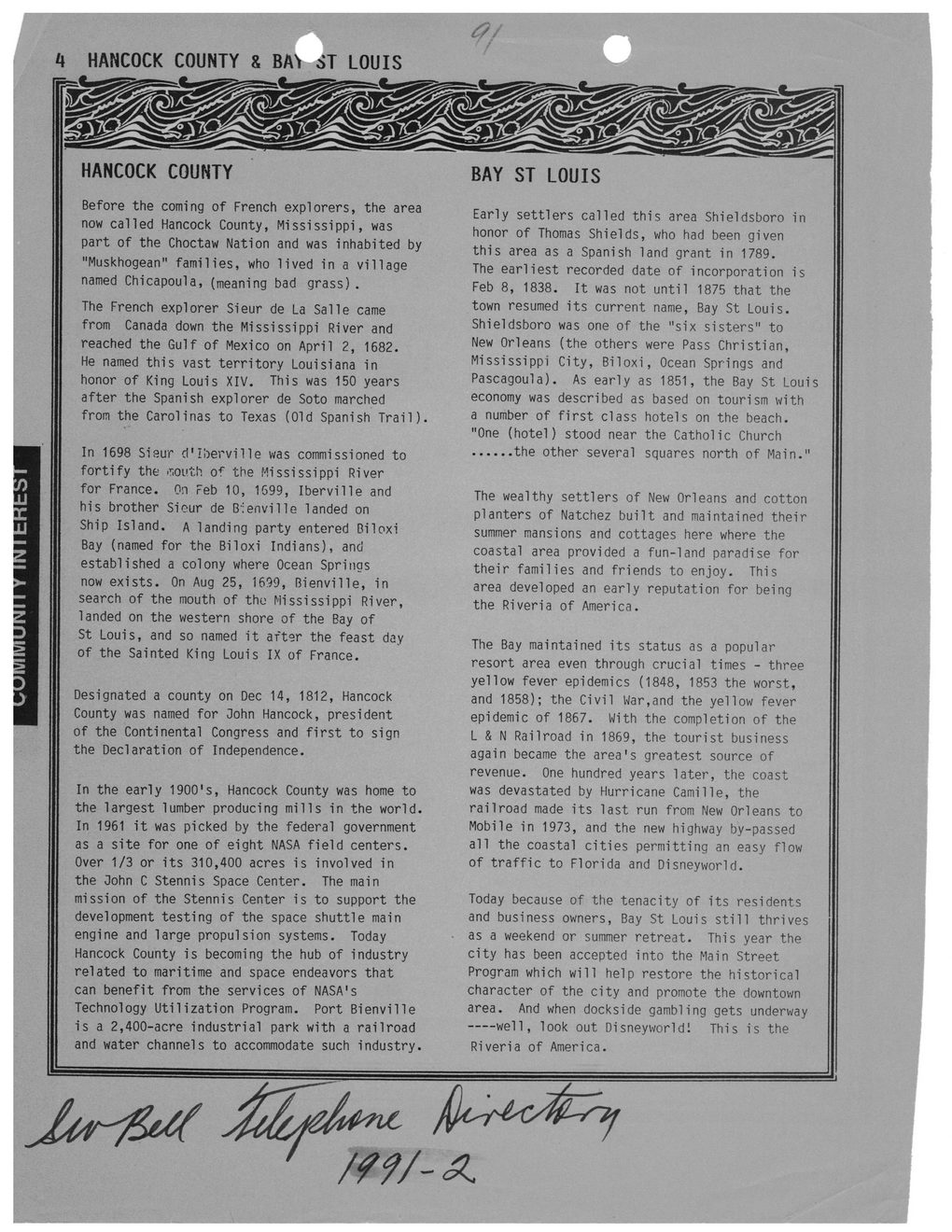This text was obtained via automated optical character recognition.
It has not been edited and may therefore contain several errors.
HANCOCK COUNTY Before the coming of French explorers, the area now called Hancock County, Mississippi, was part of the Choctaw Nation and was inhabited by "Muskhogean" families, who lived in a village named Chicapoula, (meaning bad grass) . The French explorer Sieur de La Salle came from Canada down the Mississippi River and reached the Gulf of Mexico on April 2, 1682. He named this vast territory Louisiana in honor of King Louis XIV. This was 150 years after the Spanish explorer de Soto marched from the Carolinas to Texas (Old Spanish Trail). In 1698 Sieur d'Iberville was commissioned to fortify the >r.outh o*' the Mississippi River for France. On Feb 10, 1G99, Iberville and his brother Sieur de Bienville landed on Ship Island. A landing party entered Biloxi Bay (named for the Biloxi Indians), and established a colony where Ocean Springs now exists. On Aug 25, 1699, Bienville, in search of the mouth of thu Mississippi River, landed on the western shore of the Bay of St Louis, and so named it after the feast day of the Sainted King Louis IX of France. Designated a county on Dec 14, 1812, Hancock County was named for Oohn Hancock, president of the Continental Congress and first to sign the Declaration of Independence. In the early 1900's, Hancock County was home to the largest lumber producing mills in the world. In 1961 it was picked by the federal government as a site for one of eight NASA field centers. Over 1/3 or its 310,400 acres is involved in the Oohn C Stennis Space Center. The main mission of the Stennis Center is to support the development testing of the space shuttle main engine and large propulsion systems. Today Hancock County is becoming the hub of industry related to maritime and space endeavors that can benefit from the services of NASA's Technology Utilization Program. Port Bienville is a 2,400-acre industrial park with a railroad and water channels to accommodate such industry. BAY ST LOUIS Early settlers called this area Shieldsboro in honor of Thomas Shields, who had been given this area as a Spanish land grant in 1789. The earliest recorded date of incorporation is Feb 8, 1838. It was not until 1875 that the town resumed its current name, Bay St Louis. Shieldsboro was one of the "six sisters" to New Orleans (the others were Pass Christian, Mississippi City, Biloxi, Ocean Springs and Pascagoula). As early as 1851, the Bay St Louis economy was described as based on tourism with a number of first class hotels on the beach. "One (hotel) stood near the Catholic Church ......the other several squares north of Main." The wealthy settlers of New Orleans and cotton planters of Natchez built and maintained their summer mansions and cottages here where the coastal area provided a fun-1 and paradise for their families and friends to enjoy. This area developed an early reputation for being the Riveria of America. The Bay maintained its status as a popular resort area even through crucial times - three yellow fever epidemics (1848, 1853 the worst, and 1858); the Civil War,and the yellow fever epidemic of 1867. With the completion of the L & N Railroad in 1869, the tourist business again became the area's greatest source of revenue. One hundred years later, the coast was devastated by Hurricane Camille, the railroad made its last run from New Orleans to Mobile in 1973, and the new highway by-passed all the coastal cities permitting an easy flow of traffic to Florida and Disneyworld. Today because of the tenacity of its residents and business owners, Bay St Louis still thrives as a weekend or summer retreat. This year the city has been accepted into the Main Street Program which will help restore the historical character of the city and promote the downtown area. And when dockside gambling gets underway -----well, look out Disneyworld! This is the Riveria of America. ' W9/-A.

BSL 1991 To 1995 1991 Phone Directory (1)